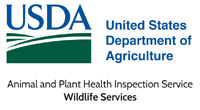United States Department of Agriculture: Animal and Plant Health Inspection Service

United States Department of Agriculture Wildlife Services: Staff Publications
Document Type
Article
Date of this Version
2023
Citation
Movement Ecology (2023) 11: 74
doi: 10.1186/s40462-023-00435-9
Abstract
Contact among animals is crucial for various ecological processes, including social behaviors, disease transmission, and predator–prey interactions. However, the distribution of contact events across time and space is heterogeneous, influenced by environmental factors and biological purposes. Previous studies have assumed that areas with abundant resources and preferred habitats attract more individuals and, therefore, lead to more contact. To examine the accuracy of this assumption, we used a use-available framework to compare landscape factors influencing the location of contacts between wild pigs (Sus scrofa) in two study areas in Florida and Texas (USA) from those influencing non-contact space use. We employed a contact-resource selection function (RSF) model, where contact locations were defined as used points and locations without contact as available points. By comparing outputs from this contact RSF with a general, population-level RSF, we assessed the factors driving both habitat selection and contact. We found that the landscape predictors (e.g., wetland, linear features, and food resources) played different roles in habitat selection from contact processes for wild pigs in both study areas. This indicated that pigs interacted with their landscapes differently when choosing habitats compared to when they encountered other individuals. Consequently, relying solely on the spatial overlap of individual or population-level RSF models may lead to a misleading understanding of contact-related ecology. Our findings challenge prevailing assumptions about contact and introduce innovative approaches to better understand the ecological drivers of spatially explicit contact. By accurately predicting the spatial distribution of contact events, we can enhance our understanding of contact based ecological processes and their spatial dynamics.
Supplemental material
Included in
Animal Sciences Commons, Natural Resources and Conservation Commons, Natural Resources Management and Policy Commons, Other Environmental Sciences Commons, Other Veterinary Medicine Commons, Terrestrial and Aquatic Ecology Commons, Veterinary Infectious Diseases Commons, Veterinary Microbiology and Immunobiology Commons, Veterinary Preventive Medicine, Epidemiology, and Public Health Commons


Comments
United States government work
and
License: CC BY 4.0 (article), CC0 (data)